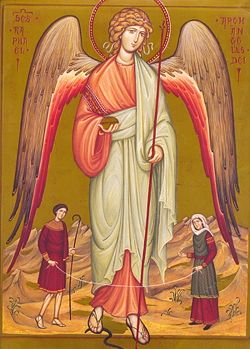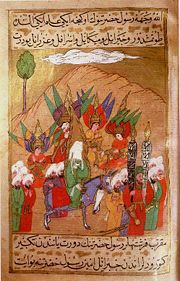Raphael (angel)
| Saint Raphael | |
|---|---|
 The Archangel Raphael |
|
| Archangel | |
| Venerated in | Christianity, Judaism, Islam |
| Feast | September 29; October 24 (local calendars and among Traditional Roman Catholics) |
| Attributes | Archangel holding a bottle or flask; Archangel walking with Tobias; Archangel; young man carrying a fish; young man carrying a staff |
| Patronage | apothecaries; blind people; bodily ills; druggists; archdiocese of Dubuque, Iowa; eye problems; guardian angels; happy meetings; insanity; lovers; mental illness; nightmares, nurses; pharmacists; physicians; archdiocese of Seattle, Washington; shepherds; sick people; travelers; young people |
Saint Raphael (Standard Hebrew רָפָאֵל, Rāp̄āʾēl, "It is God who heals", "God Heals", "God, Please Heal", Arabic: رافائيل, Rāfāʾīl) is the name of an archangel of Judaism, Christianity and Islam, who performs all manner of healing.
Contents |
Raphael in Judaism
The angels mentioned in the older books of the Hebrew Bible are without names. Indeed, Rabbi Shimon ben Lakish of Tiberias (A.D. 230-270), asserted that all the specific names for the angels were brought back by the Jews from Babylon, and modern commentators would tend to agree.
Of seven archangels in the angelology of post-Exilic Judaism, only Michael, mentioned as archangel (Daniel 12:1) and Gabriel are mentioned by name in the scriptures that came to be accepted as canonical by all Christians. Raphael is mentioned by name in the Book of Tobit, which is accepted as canonical by Catholics and Orthodox. Four others, however, are named in the 2nd century BC Book of Enoch (chapter xxi): Uriel, Raguel, Sariel, and Jarahmeel.
The Hebrew word for a doctor of medicine is Rophe connected to the same root as Raphael.
Raphael in Christianity
The name of the archangel Raphael appears only in the Deuterocanonical Book of Tobit. The Book of Tobit is considered canonical by Roman Catholic, Orthodox and some Protestant Christians. Raphael first appears disguised in human form as the travelling companion of the younger Tobias, calling himself "Azarias the son of the great Ananias". During the adventurous course of the journey the archangel's protective influence is shown in many ways including the binding of the demon in the desert of upper Egypt. After the return and the healing of the blindness of the elder Tobias, Azarias makes himself known as "the angel Raphael, one of the seven, who stand before the Lord" Tobit 12:15. Compare the unnamed angels in John's Revelation 8:2.
Regarding the healing powers attributed to Raphael, we have little more than his declaration to Tobit (Tobit, 12) that he was sent by the Lord to heal him of his blindness and to deliver Sarah, his daughter-in-law, from the devil (Asmodeus) that was the serial killer of her husbands. Among Catholics, he is considered the patron saint of medical workers and [[ ]]s, and may be petitioned by them or those needing their services.

The feast day of Saint Raphael was included for the first time in the General Roman Calendar in the year 1921, for celebration on October 24. With the reform of the Roman Catholic Calendar of Saints in 1969, this feast was transferred to September 29 for celebration together with Saint Michael and Saint Gabriel.[1] The Church of England has also adopted the September 29 date for celebrating "Michael and All Angels".[2] In some local calendars and among Traditional Roman Catholics, St Raphael's feast is still celebrated on October 24.[3]
Raphael has made only a light impression on Catholic geography: Saint Raphaël, France and Saint Raphaël, Quebec, Canada; San Rafaels in Argentina, Bolivia, Colombia, Costa Rica, Chile, Mexico, Peru, the Philippines and in Venezuela as San Rafael de Mohán and San Rafael de Orituco. In the United States, San Rafaels inherited from Mexico survive in California (where besides the city there are San Rafael Mountains), in New Mexico, and in Utah, where the San Rafael River flows seasonally in the San Rafael Desert.
In the New Testament, only the archangels Gabriel and Michael are mentioned by name Luke 1:19-26, Jude 1:9. John 5:1-4 refers to the pool at Bethesda, where the multitude of the infirm lay awaiting the moving of the water, for "an angel of the Lord descended at certain times into the pond; and the water was moved. And he that went down first into the pond after the motion of the water was made whole of whatsoever infirmity he lay under". Because of the healing role assigned to Raphael, this particular angel is generally associated with the archangel.
Raphael is sometimes shown (usually on medallions) as standing atop a large fish or holding a caught fish at the end of a line. This is a reference to Book of Tobit (Tobias), where he told Tobias to catch a fish, and then uses the galbladder to heal Tobit's eyes, and to drive away Asmodeus by burning the heart and liver.[4]
Raphael in Islam
According to the Hadith, Raphael (Israfil in Arabic) is the Angel responsible for signaling the coming of Judgment Day by blowing the horn (namely Sûr) and sending out a "Blast of Truth". Unlike Gabriel (Jibrail) and Michael (Mikail), this archangel was not mentioned by name in the Quran.
The horn (sûr) will be blown two times. The first blow of the Sûr signals the beginning of the Judgment Day and with the second blow, all the souls are gathered somewhere between heaven and hell, and interrogated for their good deeds and sins.
Raphael in the Book of Enoch
Raphael bound Azazel under a desert called Dudael according to Enoch 10:5-7:
"And again the Lord said to Raphael: 'Bind Azazel hand and foot, and cast him into the darkness: and make an opening in the desert, which is in Dudael, and cast him therein. And place upon him rough and jagged rocks, and cover him with darkness, and let him abide there for ever, and cover his face that he may not see light. And on the day of the great judgement he shall be cast into the fire."
Raphel in Paradise Lost
The angel Raphael, as well as many other prominent angels appear in John Milton's Paradise Lost. Where he is assigned by God to re-warn Adam concerning the sin of eating of the Tree of the knowledge of good and evil. He also expounds to Adam the war in heaven in which the Archangel Lucifer fell and became Satan and the creation of Earth
References
- ↑ "Calendarium Romanum" (Libreria Editrice Vaticana, 1969), p. 143)
- ↑ Calendar of saints (Church of England)#September
- ↑ See the General Roman Calendar as in 1954, the General Roman Calendar of Pope Pius XII, and the General Roman Calendar of 1962
- ↑ saintr02.htm Patron Saints Index
See also
- Angel
- Angels in Islam
- Archangel
- Gabriel (archangel)
- List of names referring to El
- Michael (archangel)
- Uriel (archangel)
